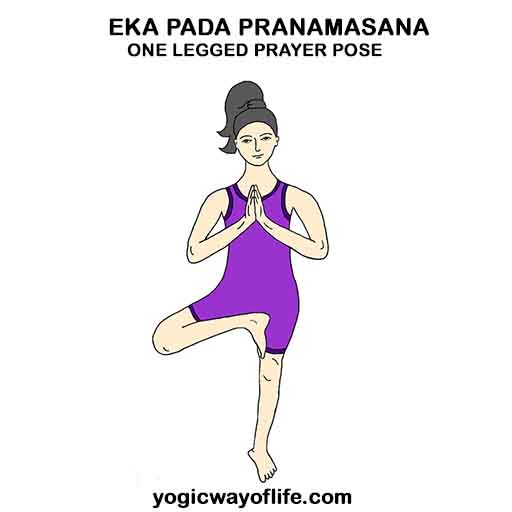Eka Pada Pranamasana or the one-legged prayer pose is a balancing asana. In Sanskrit, Eka means one, Pada means foot, Pranama means prayer and Asana means pose. Eka Pada Pranamasana is the one-legged prayer pose. Practitioners must be familiar with Pranamasana, the regular prayer pose which is the starting pose for the Sun Salutation. Here the only difference is that one leg is raised and the sole of the feet is placed next to the upper thigh.
Eka Pada Pranamasana is a balancing pose which helps the practitioner to maintain a sense of balance and equilibrium and also strengthens the leg muscles.

How to do Eka Pada Pranamasana (One-Legged Prayer Pose)?
- Stand erect on the floor with hands on the sides.
- Look straight ahead and breathe normally.
- Bring the two palms together in the prayer pose.
- Raise the right leg and place the sole of the right foot on the inner side of the upper left thigh.
- Maintain balance and remain in this position for as long as you are comfortable.
- Breathe normally during the final pose.
- One can fix the gaze ahead on an object of concentration. Try to maintain awareness along with the breathing process.
- To release the pose, bring back the raised foot to the standing position. One can try this asana with the left leg raised as well.
Benefits of Eka Pada Pranamasana (One-Legged Prayer Pose)
- Eka Pada Pranamasana is a balancing pose. It helps to develop the sense of equilibrium as the entire weight is supported on one leg.
- It strengthens the muscles of the leg, foot and ankle.
- This practice improves awareness as the balance can be lost if the mind wavers during the practice. Balancing requires close coordination of many muscles in the foot, ankle, lower legs, thighs and the lower back. By maintaining awareness, this fine tuning is achieved.
- In the Indian Puranas, there are many instances of Rishis doing austerities in the one-legged Prayer pose. It is said that Sage Bhagiratha did penance in this pose to propitiate Lord Shiva, to help bring down the Holy river Ganges to the earth. Sage Bhagiratha had earlier propitiated Lord Brahma to bring down the Ganges to earth. But no one could arrest the force of the Ganges when it flows down and hence he prayed to Lord Shiva, standing on one foot. Lord Shiva appeared and agreed to arrest the force of the descending Ganges using his tresses. He stood on a nearby peak and took the force of the decent on his matted locks of hair. Hence Lord Shiva is depicted as the Ganges flowing from his matted hair.
